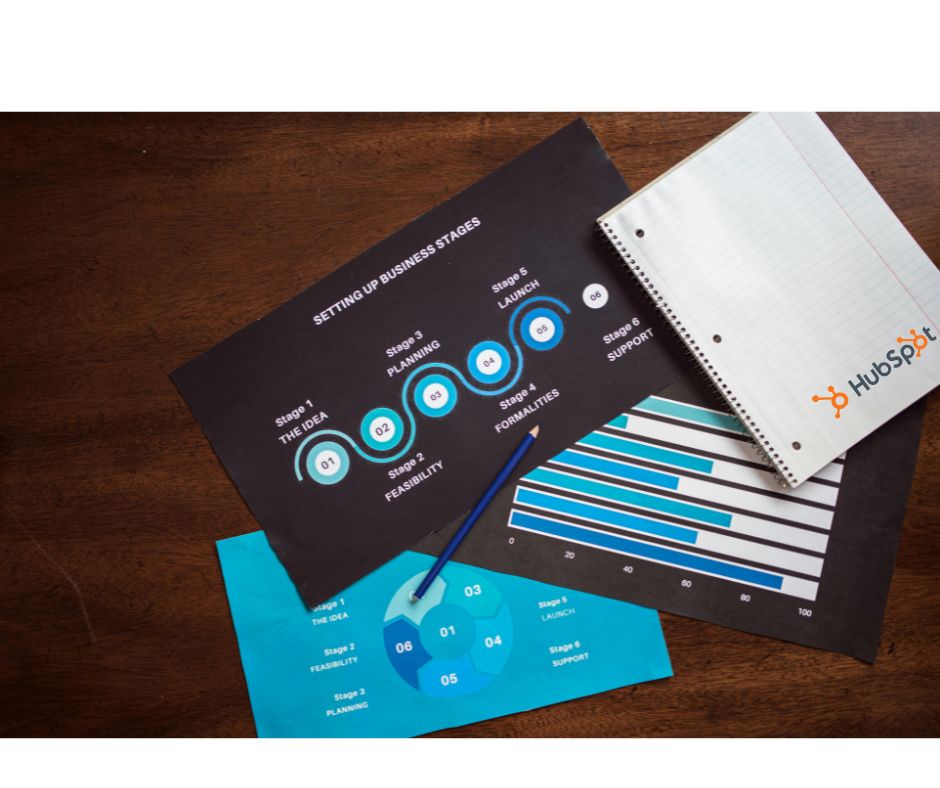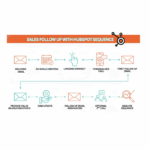
How to Set Up Custom Deal Stages in HubSpot for a Smarter Sales Process
Why Your Sales Process Deserves More Than Default Stages

Every sales team is unique. Every product, service, and customer journey has its own rhythm and nuances. Yet, many businesses start their HubSpot journey with a default set of deal stages – “Appointment Scheduled,” “Qualified to Buy,” “Presentation Scheduled,” and so on. While these generic stages are a decent starting point, they often fall short.
The Problem: Relying solely on HubSpot’s default stages can quickly lead to inaccurate forecasting, fuzzy pipeline visibility, and a disconnect between your CRM and your actual sales motion. Without stages that truly reflect your specific milestones and the progression of your deals, your sales team might be struggling to manage their pipeline effectively, and your sales managers might be making decisions based on incomplete or misleading data.
The Solution: The power of HubSpot lies in its adaptability. By customizing your deal stages, you can align your CRM precisely with your unique sales process, transforming it from a mere contact database into a dynamic, intelligent sales management tool.
What this post will cover: This guide will walk you through the compelling benefits of custom deal stages, provide a crucial planning process before you even touch HubSpot, give you a step-by-step setup guide, and share essential best practices to ensure your custom stages genuinely empower your sales team and improve your bottom line.
The Compelling Benefits of Custom Deal Stages
Moving beyond generic stages isn’t just about aesthetics; it’s about optimizing your sales engine for peak performance. Here’s why customizing your HubSpot deal stages is a game-changer:
- Benefit 1: Reflect Reality: Your sales process isn’t a one-size-fits-all template. Custom stages allow you to precisely mirror the actual steps, touchpoints, and critical milestones in your unique sales cycle, from initial discovery to contract signing. This makes your CRM a true reflection of your business.
- Benefit 2: Improve Forecasting Accuracy: Generic stages with broad probabilities lead to guesswork. By assigning custom, realistic win probabilities to each granular stage, you can generate far more reliable revenue predictions, giving leadership a clearer view of future sales.
- Benefit 3: Enhance Pipeline Visibility & Management: When stages are clearly defined and reflect your process, you can quickly identify where deals are stalling, where bottlenecks occur, and which reps might need support. This proactive visibility empowers sales managers to coach more effectively.
- Benefit 4: Boost Team Alignment & Clarity: Custom stages ensure everyone on the sales team speaks the same language. Each stage has a clear definition, meaning sales reps, managers, and even marketing teams understand what “Proposal Sent” or “Contract Negotiation” truly entails and what needs to happen next.
- Benefit 5: Enable Targeted Automation: HubSpot’s automation capabilities become exponentially more powerful with custom stages. You can trigger specific workflows, automated tasks, follow-up emails, or internal notifications based on a deal entering a custom stage, automating mundane tasks and ensuring nothing falls through the cracks.
- Benefit 6: Streamline Reporting: Goodbye, vague reports! With custom stages, you can generate much more insightful analytics on stage conversion rates, sales velocity (how quickly deals move through stages), average deal value per stage, and more. This data is critical for continuous process improvement.
Before You Click: Planning Your Ideal Deal Stages
The biggest mistake you can make is diving straight into HubSpot settings without a clear plan. Effective deal stage customization begins with strategic thinking.
- Key Point: Planning before going into HubSpot settings is absolutely crucial for success and avoids rework.
- Action 1: Map Your Current Sales Process: Get the sales team together (virtually or physically). Whiteboard or document every distinct step your ideal customer takes from being a raw lead to a closed-won or closed-lost deal. Think about the actions your sales reps take and the commitments from the prospect.
- Action 2: Define Clear Entry/Exit Criteria for Each Stage: This is vital. What must happen for a deal to move from Stage A to Stage B? Be incredibly specific. For example, “Proposal Sent” means the proposal has been verbally accepted by the client, not just emailed. “Discovery” means the salesperson has successfully identified the prospect’s pain points and confirmed budget.
- Action 3: Involve Your Sales Team: This isn’t an admin-only task. Get direct feedback and critical buy-in from the people who will use these stages daily. Their input is invaluable for creating a practical and adopted system.
- Action 4: Keep it Action-Oriented & Clear: Use concise, unambiguous, verb-based names for your stages. Examples: “Initial Contact,” “Needs Assessment,” “Demo Scheduled,” “Proposal Sent,” “Negotiating,” “Closed Won,” “Closed Lost.” Avoid jargon where possible.
- Action 5: Determine Realistic Win Probabilities: For each stage, assign a percentage likelihood that a deal at that stage will close (e.g., “Demo Scheduled” might be 20%, “Proposal Sent” 60%, “Negotiating” 85%). Be honest and realistic based on historical data if possible.
- Action 6: Consider Your Reporting Needs: What key metrics do you want to track related to deal progression? Knowing this upfront will help you define stages that make sense for your desired reports (e.g., conversion rate from “Demo Scheduled” to “Closed Won”).
Setting Up Custom Deal Stages in HubSpot
Once your planning is complete, it’s time to implement your well-thought-out sales process in HubSpot. (Note: Customizing deal stages is available in HubSpot Sales Hub Starter, Professional, and Enterprise editions. Users of the free CRM can only use default pipelines.)
Step 1: Navigate to Settings
- From your HubSpot dashboard, click the Settings icon (gear icon) in the top right navigation bar.
- In the left sidebar menu, navigate to Objects > Deals.
- Click on the Pipelines tab.

Step 2: Choose Your Pipeline
- You’ll see a dropdown menu with “Sales Pipeline” (and any other pipelines you’ve created). Select the pipeline you want to customize.
- (Quick Tip: Multiple pipelines are useful if you have distinctly different sales processes for different product lines, customer segments, or business units. For most businesses, one well-defined pipeline is sufficient to start.)
- To edit an existing pipeline, click “Edit” next to its name. To create a new one, click “Create pipeline.”

Step 3: Add, Edit, Reorder, or Delete Stages
- Under the pipeline, you’ll see your current deal stages.
- To add a new stage, click the blue “Add a stage” button. A new stage will appear at the end.
- Name the stage clearly (e.g., “Discovery Call Complete,” “Proposal Submitted”).
- To reorder stages, simply click and drag a stage by its handle (the six dots) to move it to the desired position in your sales flow.
- To edit an existing stage name, click on the stage name, make your changes, and hit enter.
- To delete an unnecessary default stage (or any custom stage), hover over the stage and click the “Delete” icon (trash can). Important: If there are deals in a stage you’re deleting, HubSpot will prompt you to migrate those deals to another existing stage.

Step 4: Assign Win Probabilities
- For each stage, you’ll see a “Probability (%)” field.
- Enter the percentage likelihood of closing a deal that reaches this stage. This directly impacts your HubSpot sales forecasting.
- HubSpot automatically assigns 100% to “Closed Won” and 0% to “Closed Lost.”

Step 5: (Optional but Recommended) Configure Stage Properties
- Next to each stage name, click on “Automate” or “Set properties” (depending on your HubSpot version/features).
- Here, you can configure properties that appear or are required when a deal enters or leaves this stage. For example, you might:
- Require the “Close Date” and “Amount” to be filled before a deal can move to “Closed Won.”
- Require a “Demo Date” to be entered to move from “Lead Qualified” to “Demo Scheduled.”
- This ensures data integrity and consistency for better reporting.


Step 6: Save Your Changes
- Once you’ve made all your adjustments, don’t forget to click the “Save” button at the bottom of the screen. Your changes won’t be applied until you do!
(Visual Cue: In your actual blog post, including screenshots for each major step – navigating to settings, editing pipelines, adding/editing stages, and assigning probabilities – will significantly enhance clarity for your readers.)

Best Practices for Effective Custom Deal Stages
Setting up your stages is just the first step. To ensure they genuinely empower your sales team and improve your process, follow these best practices:
- Keep it Concise: Avoid creating too many stages. A pipeline with 5-10 distinct stages is typically manageable and effective. Too many stages can lead to “pipeline paralysis” and confusion.
- Ensure Clarity: Every stage name and its associated entry/exit criteria should be unambiguous and universally understood by everyone on your sales team.
- Focus on Milestones: Each stage should represent a significant step forward, a key commitment from the prospect, or a critical action by the sales rep. Avoid stages for internal admin tasks.
- Maintain Consistency: If your business uses multiple sales pipelines, try to maintain logical consistency in stage naming and progression where applicable, even if the specifics differ.
- Train Your Team: A perfect pipeline is useless if your team doesn’t understand or adopt it. Conduct thorough training sessions, explain the ‘why’ behind the changes, and ensure everyone knows how to use the new stages and their criteria.
- Review and Iterate: Your sales process isn’t static. Periodically review and refine your stages (e.g., quarterly or annually) based on performance data, feedback from your sales team, and changes in your market or product.
Common Mistakes to Avoid
Even with careful planning, it’s easy to fall into common traps when customizing deal stages:
- Mistake 1: Creating too many or too few stages: Too many leads to micro-management; too few leads to a lack of visibility. Find your sweet spot.
- Mistake 2: Vague stage names or unclear definitions: “Prospecting” or “Qualifying” aren’t actionable enough. Define “what happens when” at each step.
- Mistake 3: Not involving the sales team in the planning: This is a recipe for low adoption and resistance. Their buy-in is paramount.
- Mistake 4: Forgetting to update win probabilities accurately: This can skew your forecasting and lead to poor strategic decisions. Review them regularly.
- Mistake 5: Setting it up and never reviewing/adjusting it later: Your sales process evolves. Your stages should too.
- Mistake 6: Not leveraging stage properties for data integrity: Missing crucial data at key stages can cripple your reporting and automation efforts down the line.
Take Control of Your Sales Pipeline
Your sales pipeline is the lifeblood of your business, and HubSpot’s deal stages are its essential arteries. By moving beyond generic defaults and taking the time to set up custom deal stages, you transform HubSpot from a passive CRM into a dynamic, intelligent tool precisely tailored to your unique sales motion.
The result? Unparalleled clarity into your pipeline, vastly improved forecasting accuracy, robust reporting capabilities, and an empowered sales team aligned on common goals and a shared process.
Don’t let generic stages hold your sales team back. Review your current HubSpot deal stages today and start planning your custom setup. Take control of your sales pipeline and watch your business thrive.
Need expert guidance to optimize your HubSpot Sales process? Contact Mobius NEXT for a consultation.
Resources:
- HubSpot Knowledge Base (official documentation):
- https://knowledge.hubspot.com/deals/create-and-edit-deal-pipelines-and-stages (This is a highly relevant official guide)
- https://knowledge.hubspot.com/reports/use-your-sales-pipeline-to-forecast-revenue
- HubSpot Sales Blog:
- https://blog.hubspot.com/sales (For articles on sales process, pipeline management, etc.)



